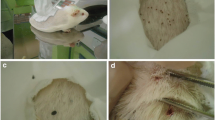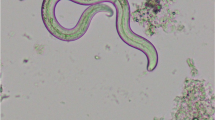Abstract
Domestic cats, 11 other species of carnivorous mammals, 6 species of snakes, and whitebacked vultures were tested for their possible role as definitive hosts ofBenoitia besnoiti by feeding with cystic material from chronically infected bovines. None of the species tested is a definitive host; hence, the life cycle of this parasite remains obscure. In attempts to produce clinical cases of besnoitiosis by experimental infection, bovines were inoculated IV, SC, and IP with cystozoites or tachyzoites. Immunosuppression of the animals was essential for the development of severe cases and skin lesions; cystozoites proved to be more pathogenic than tachyzoites.
Similar content being viewed by others
References
Bigalke RD (1968) New concepts on the epidemiological features of bovine besnoitiosis as determined by laboratory and field investigations. Onderstepoort J Vet Res 35:3–138
Bigalke RD (1981) Besnoitiosis and globidiosis. Curr Top Vet Med Anim Sci 6:429–442
Ito S, Tsunoda K, Shimura K (1978) Life cycle of the large type ofIsospora bigemina of the cat. Natl Inst Anim Health Q 18:69–82
Levine ND (1982) Taxonomy and life cycles of coccidia. In: Long PL (ed) The biology of the coccidia. Edward Arnold, London, pp 1–33
Peteshev VM, Galuzo IG, Polomoshnov AP (1974) Koshkidefinitivnye khozyaeva besnoitii (Besnoitia besnoiti). Azv Akad Nauk Kaz SSr Ser Biol 1:33–38 (in Russian)
Pols JW (1960) Studies on bovine besnoitiosis with special reference to the aetiology. Onderstepoort J Vet Res 28:265–356
Rommel M (1975) Neue Erkenntnisse zur Biologie der Kokzidien, Toxoplasmen, Sarkosporidien und Besnoitien. Berl Muench Tieraerztl Wochenschr 88:112–117
Smith DD, Frenkel JK (1977)Besnoitia darlingi (Protozoa: Toxoplasmatinae): cyclic transmission by cats. J Parasitol 63:1066–1071
Soulsby EJL (1982) Helminths, arthropods and protozoa of domesticated animals. Bailliere Tindall, London, p 686
Uvaliev IU, Popov YUA, Susleimenov TT (1979) Experimental infection of kittens withBesnoitia. Protozool Abstr 7:2450 (citation)
Wallace GD, Frenkel JK (1975)Besnoitia species (Protozoa, Sporozoa, Toxoplasmatidae): recognition of cyclic transmission by cats. Science 188:369–371
Author information
Authors and Affiliations
Rights and permissions
About this article
Cite this article
Diesing, L., Heydorn, A.O., Matuschka, F.R. et al. Besnoitia besnoiti: Studies on the definitive host and experimental infections in cattle. Parasitol Res 75, 114–117 (1988). https://doi.org/10.1007/BF00932710
Accepted:
Issue Date:
DOI: https://doi.org/10.1007/BF00932710




